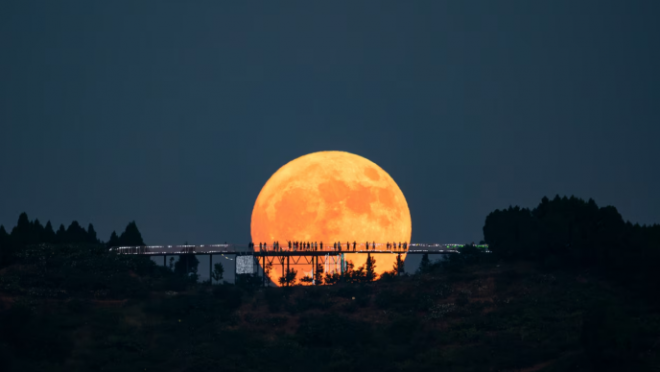November's supermoon tonight: Here’s when and how to see it
November's supermoon tonight: Here’s when and how to see it

Stargazers across the world will witness a breathtaking sight tonight (5 November) as the largest and brightest full moon of 2025—known as the “beaver moon”—rises in the evening sky.
This is the second in a series of three consecutive supermoons closing out the year, and it promises to be the most dazzling. The moon will appear large, luminous, and golden, bright enough to cast faint shadows and illuminate the night from dusk to dawn.
A closer, brighter moon
Tonight’s moon will orbit about 17,000 miles nearer to Earth than usual, making it appear roughly seven percent larger and up to 16 percent brighter than a typical full moon.
A supermoon occurs when the moon reaches its full phase near perigee—the closest point in its elliptical orbit around Earth. This particular alignment, known as a perigee full moon, makes the lunar disk look unusually big and radiant.
Not every supermoon is equal, however. Some occur slightly before or after perigee, reducing their brilliance. November’s moon is special because its closest approach to Earth coincides almost perfectly with the moment it becomes full—creating one of the most impressive supermoon events in recent years.
The moon won’t appear this large or bright again until 24 November 2026, when the next “beaver moon” makes a similar close pass by Earth.
Why it’s called the “beaver moon”
The name “beaver moon” comes from traditional Native American and Indigenous North American calendars. It marks the time of year when beavers build their winter lodges and trappers historically set their last traps before rivers froze over.
When and how to see it
While the moon officially becomes full at 13:19 UTC on 5 November, the most striking views will be just after moonrise this evening. The first hour after it appears above the eastern horizon offers the most dramatic sight.
At that low angle, the “moon illusion” makes it seem larger than it actually is—an optical effect that occurs when our brains compare the moon’s size to nearby buildings or trees. The low position in the sky also gives it a warm golden-orange glow, as Earth’s atmosphere scatters shorter blue light waves and lets the redder tones shine through.
No special equipment is needed to enjoy the view, but photographers are encouraged to frame the moon with landmarks, trees, or silhouettes to create depth and perspective. Even with a smartphone, capturing the moonrise against a familiar skyline can produce stunning results.
A night for stargazers
Throughout the night, the moon will travel through the zodiacal constellation Taurus, the bull. Its bright glow may outshine nearby stars, but a few celestial companions will still be visible.
Just to its side lies Aldebaran—a vivid orange star marking the bull’s fiery eye—and the Pleiades, or Seven Sisters, a famous cluster of blue-white stars about 330 light-years away.
Together, the moon, Aldebaran, and the Pleiades form a striking triangle in the sky—a rare and beautiful alignment that adds to the night’s allure.
As the golden supermoon rises, lighting up the November sky, it serves as a reminder of nature’s rhythm and our planet’s place within the wider universe—a quiet moment of wonder that connects science, culture, and timeless celestial beauty.


